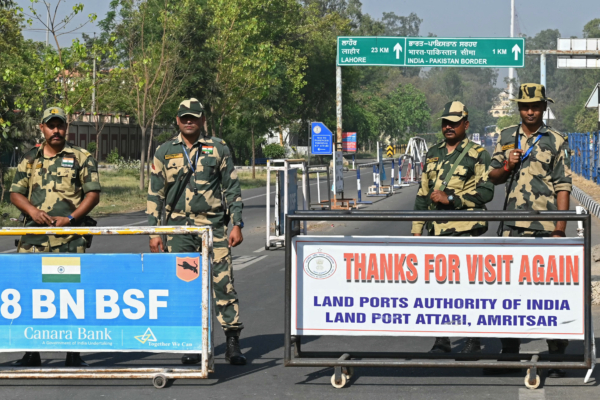India and Pakistan have been steadily expanding their military capabilities since the 2019 conflict, raising concerns among military experts that even a limited local conflict between the two nuclear-armed neighbors could lead to potentially dangerous consequences of uncontrollable escalation.
Last month, after a terrorist attack targeting tourists in the Indian-controlled Kashmir region, India accused Pakistani authorities of involvement. Indian Prime Minister Narendra Modi vowed to mete out punishment to the masterminds behind the attack, promising consequences beyond imagination.
Pakistan denied any involvement in the terrorist attack and warned of retaliation if attacked.
In 2019, following a bomb attack on an Indian military convoy in the Kashmir region, India conducted airstrikes inside Pakistan and claimed to have destroyed terrorist camps. Pakistan retaliated by launching airstrikes on India.
Since gaining independence, India and Pakistan have clashed multiple times in the Kashmir region, including wars in 1948, 1965, and 1971. Both countries assert sovereignty over the region. With both nations acquiring nuclear weapons in the 1990s, the region has become one of the most dangerous powder kegs in the world.
Military experts indicate that unless pushed to the brink, neither side is likely to use nuclear weapons. However, even in a localized conflict, there is still a risk of rapid escalation.
Experts suggest that in such conflicts, both sides may deploy fighter jets, missiles, or drones, but India, with significantly more resources than Pakistan, may have greater endurance in sustained combat.
Frank O’Donnell, a resident researcher in the South Asia Program at the Stimson Center in Washington, noted that decision-makers in both countries currently have a higher tolerance for the risk of conflict escalation than in 2019, when they successfully avoided using nuclear weapons during the conflict.
“However, if there is a lack of clear consensus on specific actions and their consequences, it could trigger the risk of unintentional conflict escalation,” he added.
Since 2019, both sides have acquired new military equipment, opening up new options for conventional strike operations.
Muhammad Faisal, a South Asia security researcher at the University of Sydney Institute of Technology, stated that both sides believe they are in a more advantageous position compared to the previous conflict, especially with India introducing 36 Rafale fighter jets, one of the most advanced in the West.
On the other hand, Pakistan has been purchasing batches of the J-10, touted as one of China’s most advanced fighter jets, since 2022. The London-based International Institute for Strategic Studies estimates that Pakistan has at least 20 of these jets.
To address the air defense gaps exposed during the 2019 India-Pakistan conflict, India procured the battle-tested S-400 mobile air defense missile system from Russia, while Pakistan acquired the HQ-9 long-range air defense missile system based on the Russian S-300 from China.
Anil Golani, former Deputy Chief of Air Staff of the Indian Air Force and current Director of the Air Power Research Center in New Delhi, acknowledged improvements in their arsenal since 2019, albeit recognizing the domestic calls for action. However, he personally believes that neither India nor Pakistan seek a full-scale conflict.
Any conflict between India and Pakistan is shadowed by China, India’s archenemy and Pakistan’s close ally and major military equipment supplier. The United States has urged both countries to defuse tensions, closely monitoring any potential conflicts to assess China’s air force capabilities.
The J-10 fighter jets and PL-15 missiles from China have not been tested in combat scenarios.
“This could be a technological showdown between the West and China,” Faisal said, pointing out the dilemma India faces in deploying air formations toward Pakistan while also needing to guard against China’s advancements.
China and India briefly clashed in a border war in 1962, and in 2022, skirmishes occurred along the Himalayan border.
Pakistan operates a fleet of F-16 fighter jets purchased from the United States decades ago during better relations with Washington. In 2019, these F-16 jets were deployed near the India-Pakistan border, sparking protests from India to the United States. Currently, relations between India and Washington have markedly improved.
Pakistan tested a surface-to-surface ballistic missile with a range of 450 kilometers last Saturday (May 3) to demonstrate readiness for any potential conflict.
The 2019 India-Pakistan border conflict nearly spiraled out of control and was eventually mediated by the United States. During the standoff, both sides repeatedly threatened missile launches.
Kaiser Tufail, a former fighter pilot with the Pakistan Air Force, noted that India failed to establish deterrence during the 2019 conflict and is likely to seek more impactful actions this time, introducing greater risks.
In response to the situation, Modi stated that had the Rafale fighter jets, ordered by the country during the 2019 conflict, been available, the outcome might have been different.
“If the situation escalates beyond what we saw in 2019, it will be very dangerous,” Tufail warned, emphasizing the extreme dangers of direct confrontation between nuclear-armed nations.
(Adapted from reports from Reuters)

